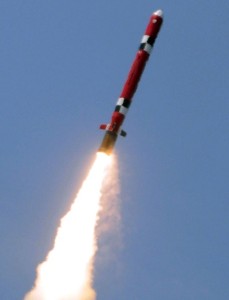Three years ago, South Korean media reported that a new cruise missile, with a range of 1,000 kilometers had secretly entered production in 2008. This has followed a series of test flights, some conducted in 2006, as mentioned in a US embassy brief published by Wikileaks.
The recent information and video release indicates both programs are well. The ballistic missile program is progressing through flight-testing. The short-range ballistic Hyunmoo II ballistic missile with a range of 300 km uses solid propellant and has GPS/INS guidance, enabling it to hit a target at ‘several tens of meters’ accuracy. To compensate for the relatively low accuracy it is expected the warhead uses cluster munitions. Hyunamoo II has the general shape of the Russian Iskander missile. The ready to fire missiles are carried in four trailer-mounted cylindrical launchers-containers.
The majority of the work took place at the South Korean ADD, with assistance from abroad. These developments were conducted at low profile, as Seoul was facing significant U.S. objection to such activities.

Hyunmoo 3 cruise missile under development at LIG Nex-1 under the ADD program is expected to become operational by 2014. Photo: ADD
The Koreans began experimenting with ballistic missiles during the 1980s, converting a Nike Hercules Surface to Air missile into a ballistic missile, a process similar to that taken be the Chinese converting an SA-2 into the CSS-8 ballistic missile. While the Koreans strived to extend the range and payload of their missiles, to meet the challenge posed by North Korean weapons, they were content with the quiet understanding form Washington to limit their missile’s range to 180 km; Since the mid- 1990s Seoul gradually expanded the limits of their missiles, along with U.S. relaxation of export permits, providing Seoul access to the ATACMS-1a missile, meeting the upper limit of the Missile Technology Control Regime (MTCR). South Korea has accepted the limitations of MTCR but public opinion in the country is calling for that limit to be broken, thus placing the entire area of its hostile neighbor North Korea vulnerable to ballistic missile attack from the south. Needless to say, North Korea is not accepting any limitations of missile development, manufacturing or export.In parallel, the Koreans began development of a cruise missile, initially reaching 500km and later extending maximum range beyond 1000km, both challenging the MTCR limits. Most recently the missile attained further increased range of 1,500 km, placing at risk not only North Korea, but also parts of China and Japan.

Hyunmoo 2 short range ballistic missile was developed by South Korea to comply with the MTCR restrictions. More advanced versions are likely to surpass those limits. The missile is likely to have an accuracy of about 30 meter (CEP) and is equipped with a cluster munition warhead. Photo released by ADD.
The Hyunmoo III cruise missile currently undergoing flight-testing is expected to become operational by 2014. These missiles are likely being developed with foreign assistance; according to unconfirmed data, the ADD is cooperating with the German-Swedish Taurus consortium, as the Europeans are particularly interested in offering the advanced warhead developed for the Taurus 350 weapon.
The Land-based weapon is launched from a launcher container and is accelerated by a booster to reach initial speed. Its accuracy of 3-5 meters indicates the use of a terminal homing device, augmenting the midcourse guidance performed through the majority of the cruising flight by GPS/INS/terrain navigation performed through low-altitude, high subsonic speed. This family of land attack cruise missiles (LACM) includes three versions – the original ground launched long range missile (GLCM) Hyunmoo IIIA (Cheon Ryong, also known as Eagle 3) with a range of 1000 km and an air launched medium range (ALCM) and surface/submarine launch version, both having a range of more than 500 km and a warhead likely to weight 400kg. The air launched version of the missile is also known as Hyunmoo IIIB (Boramae) and the surface / submarine launched version (SLCM) is calles Hyunmoo IIIC (Chonzyong), destined for the KDX-III destroyers (each will be equipped with 30 such missiles).
These cruise missiles employ mostly domestically developed technology. Similar weapons are also developed by Pakistan, India and China. Like the Tomahawk, Hyunmoo 3 appears to be about 6 meters (19 feet) long, weighs 1.5 tons, has a half ton warhead and is launched from concealed, fortified launch sites dug up into the hills facing North Korea. The missile developer is LIG Nex1, the country’s largest precision weapon system house. Following the completion of the Hyunmoo 3 the company is expected to commence development of a supersonic cruise missile, which has yet to have its own code-name, with the state-run Agency for Defense Development.
Short Range Missiles Have Their Limits
The limited range of its missile force has always been a cause for tension, as to bring such missiles into effect as deterrent weapons they had to be forward deployed closer to the demilitarized zone (DMZ), causing alerts on both sides. In 2011 South Korea announced it is forward deploying its ATACMS missiles close to the North Korean border. ATACMS is a 610mm rocket that fits in the same size container that normally holds six 227mm MLRS rockets. The ATACMS version in South Korean service has a range of 165 kilometers. That makes it capable of reaching many targets in theater but not the strategic targets in the depth of North Korea, such as the capital Pyongyang, which is 220 kilometers north of the DMZ). South Korea only has 220 ATACMS missiles. All of them have cluster bomb warheads. Half of them are unguided, and have a range of 128 kilometers. The other half have smaller warheads, GPS guidance and a range of 165 kilometers. This is apparently the version moved close to the border, in order to make the North Koreans nervous. South Korea originally bought ATACMS in 1998 not as a deterrent weapon but to have a weapon that could go after distant North Korean artillery and large concentrations of tanks.


0 komentar
Write Down Your Responses